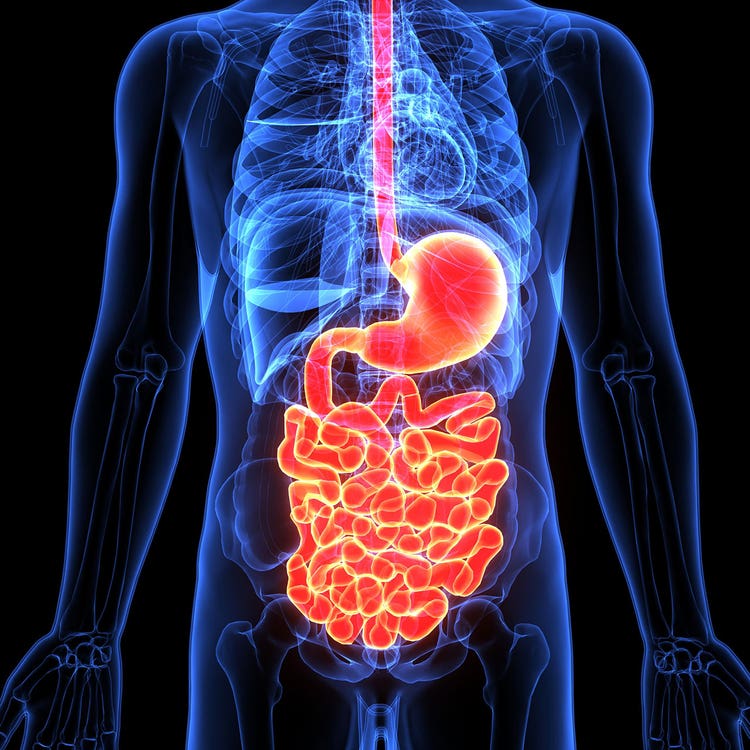Your Gut Is the Second Brain

Digestion might seem simple, yet the system controlling it is actually quite complex. Meet the enteric nervous system (ENS), the hidden force behind nutrient absorption and waste management. It might not be glamorous or pretty, but it is essential—and fascinating.
Read on for an ENS primer, with insights from Niall P. Hyland, Ph.D., senior lecturer in physiology at APC Microbiome Ireland, University College Cork; Jackie D. Wood, Ph.D., professor at The Ohio State University College of Medicine; and Scott Anderson, author (with John Cryan and Ted Dinan) of “The Psychobiotic Revolution” (National Geographic, 2017).
What is the ENS?

“To have a gut feeling” is an idiom for good reason. Our gut (digestive tract) indeed possesses its own nervous system, called the ENS. The ENS consists of nerve cells located in the stomach, small and large intestines, and anus. These cells control all GI behavior, from releasing secretions in the stomach to throwing up. “The ENS speeds up or slows down the gut as necessary, allowing time for nutrient absorption and the expulsion of fecal matter,” Hyland explains. “It also regulates blood flow to the gut and the absorption and secretion of fluid and electrolytes.”
The second brain

With more nerves than the spinal cord, the ENS is known colloquially as the “second brain.” (The “first” brain is part of the central nervous system, or CNS.) Since the ENS can coordinate GI function without input from the CNS, the gut truly has a brain of its own, Hyland says.
“Your gut can run on its own, without any oversight, more or less on autopilot,” Anderson adds. “In fact, you can cut all the nerves connecting it to the brain and it will still pump food down the chute and absorb nutrients without any supervision.”
For example, Anderson continues, “If you eat some bad sushi, [the ENS] won’t confer with your brain to figure out a plan. Instead, it will immediately speed up peristalsis [the muscular pulses that push food through your intestines] and flush the system with water. Only after the fact does your brain get notified that it’s time to seek out a bathroom ASAP.”
The CNS versus the ENS in digestion

That said, conversation between the CNS and ENS is constant. It begins the moment you sense food. In response to smells (or tastes, sights or the sounds of eating), your sensory organs send data to your brain (in the CNS). Your brain then sends information to your stomach, priming it for digestion.
Then while food passes through your gut, sensory nerve cells in its lining detect nutrient content. These cells send this information back to the brain (CNS), which might react—for example, by telling your system that you are full and should stop eating. “The CNS can ‘fine-tune’ the activity of the ENS,” Hyland says.
Meanwhile, these nerve cells in the gut also trigger reactions in the ENS. Specifically, they cause other cells and organs to secrete digestive enzymes to break down food and absorb nutrients, Anderson explains. For instance, they alert the gall bladder to secrete bile to break down fats, the stomach to release pepsin to break down proteins, and the pancreas to squirt out amylase to break down complex carbohydrates.
Although the CNS and ENS work in sync, they also operate independently. The CNS alone controls chewing and swallowing and the movement of food from the esophagus to the stomach. Meanwhile, the ENS controls digestive processes in the intestines and rectum exclusively.
Why does the ENS matter?

Without the ENS, the gut simply does not work, Wood says. Babies born without a complete ENS (a syndrome called Hirschsprung’s disease) are unable to have bowel movements and must undergo surgery to remove the portion of the colon missing those key neurons.
If something is wrong with the ENS, troublesome symptoms—such as irritable bowel syndrome, retching, diarrhea or constipation—can result. Many of these symptoms are related to levels of liquids secreted in the gut. Too little leads to constipation, while too much can lead to diarrhea (a purposeful behavior to flush pathogens out of the GI tract).
Opioids (such as morphine) suppress the motor neurons in the ENS that release secretions, which leads to constipation. Because of this trait, they are used (in low doses) in diarrhea medications to slow down the flow of bowel movements. “Medical students are always taught that in order to understand constipation and diarrhea, they have to understand motor neurons in the ENS that control secretion,” Wood says.
Are gut and brain health connected?

“Whether diseases of the gut affect the brain or vice versa remains a challenge to tease apart,” Hyland says. “What we do know, however, is that there are many associations between abnormal gut function and ‘brain’ disease, for example in autism spectrum disorders and Parkinson’s disease. In the case of Parkinson’s, there are ongoing investigations into whether the disease may originate in the gut and the ENS.”
Anderson agrees that mental and gut health are connected. “Chronic gut issues [such as IBS, ulcerative colitis and Crohn’s disease] can lead to anxiety and serious depression, and some psychiatrists are now including a gut check with new patients,” he says.
Mind your gut

To take care of your ENS, manage stress and avoid opiates, Wood recommends. Also, skip long-term laxative use, which, he explains, causes a lot of secretions in the digestive tract. Continuous stimulation leads to some degenerative changes in the colon in the ENS. Meanwhile, Hyland points out that “a healthy diet and gut microbiome [bacteria] will undoubtedly influence healthy gut function.”
Video credit: Lumina, Stocksy
Photo credit: bernardbodo, Thinkstock; PALMIHELP, Thinkstock; AntonioGuillem, Thinkstock; Antonio_Diaz, Thinkstock; phonprom, Thinkstock; LewisTsePuiLung, Thinkstock; nathiyai, Adobe Stock